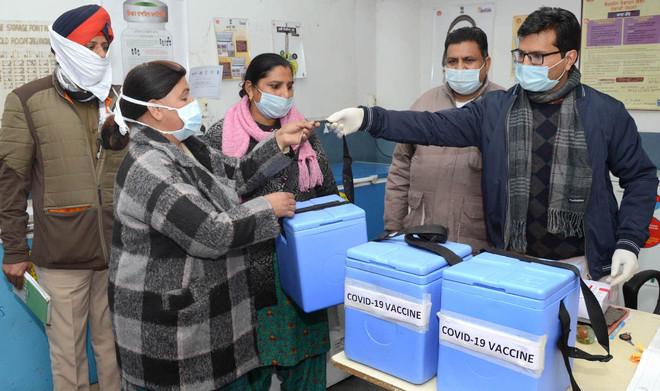COVID-19 Vaccination Slow in India, Need to Augment Domestic Production

Representational image. | Image Courtesy: Wikimedia Commons
The vaccine shortage is hitting the states again. On July 15, many Covid centres in Delhi had to be shut down. Similar woes can be heard from other states too. In Maharashtra, the health minister complained that due to a shortage of the vaccine stock, centres are operating below their capacity with only 2-3 lakh people being inoculated daily as against the capacity of 15 lakh people. Rajasthan and Punjab have also complained of shortage of vaccine supply due to which Covid centres have had to be shut down in these states.
Although the Centre has blamed the states for mismanaging the administration of vaccines given the limited supply, it appears that the Centre itself has mismanaged in anticipating the supply of vaccines from various sources. In an affidavit to the Supreme Court, the Centre considerably reduced the projected availability of vaccines for the period August-December 2021.
Table 1: Projected availability of Covid -19 vaccines from August 2021 to December 2021 (in crores)
In May, the Centre had projected the availability of nearly 217 crore vaccines over the period August-December 2021. These included vaccines from various manufacturers. These were provisional estimates with the anticipation that vaccines from global pharma companies would be available and domestic production would have been ramped up.
However, after about one-and-a-half-months, in June, this projection has been reduced to 135 crore doses of vaccines. With this, by December-end, India would reach about 173 crore doses of vaccine. In a May press release, the Centre had stated that Indian Immunologicals Limited will be in a position to start production of Covaxin from September 2021, while Haffkine Institute and BIBCOL will start production of Covaxin from November 2021.
The Centre could not devise a proper strategy towards the procurement of vaccines, with estimates not translating into actual availability, which has resulted in the shortages despite India being called the “pharmacy of the world”. Earlier, in March, due to the ill-planned policy, India already had to abruptly discontinue the supply of vaccines to other countries amid its own COVID-19 surge, thus leaving these countries in the lurch.
Domestically, too, the Centre has been sort of experimenting with the model of procurement and distribution of vaccines. From January to April, the model was that the Centre procured the vaccines from the manufacturers and distributed those to the states. From May 1, the ‘Liberalised and Accelerated Policy’ was introduced wherein 50% of the share was procured by the Centre and for the rest 50%, manufacturers could sell to the states and private providers. As a result, the states had to float global tenders for vaccines, which did not get much response from the pharmaceutical companies. With the utter failure of this policy, and the rising discontent and a reprimand from the Supreme Court, the Centre was forced to withdraw this policy. From June 21, 75% vaccines were to be procured and distributed to the states by the Centre and 25% could be procured by the private sector.
In June, the United States had also announced vaccine doses under its COVID-19 Global Response and Recovery Framework for various countries. Under this, India’s share amounts to about 2 million doses from manufacturers such as Pfizer and Moderna. However, this supply is on hold at present because of the legal negotiations around the indemnity clause that these pharma companies have been insisting upon.
Pace of Vaccination in India
The rate of vaccination has been rather slow in India. Comparing India with some of the other middle income countries shows that the pace of full vaccinations undertaken is way below that for the countries such as Mexico, Brazil, and Russia. Neighbouring country Sri Lanka also surpassed India in terms of total number of vaccinations and also the rate of vaccination.
Figure 1:
Target as against Current rate of Vaccination
If we project the current rate of vaccination, the target of fully vaccinating the adult population in India (with two doses) may be roughly achieved only by April-May 2022. We study the trend of vaccination since April 1, 2021 (for about 100 days).
In our calculations, the target is roughly 226 crore vaccine doses calculated by taking about 94 crore adult population and about 20% wastage during each dose (94x2.4=226 crore doses). This projection assumes the vaccination drive to be running smoothly without any gaps and also on a daily basis.
According to the Centre's affidavit to the Supreme Court, the projected availability of Covid -19 vaccines from August 2021 to December 2021 is 135 crore doses. That is, by December-end, India would administer about 173 crore doses of vaccine (including about 38 crore doses already administered). However, as per our projected calculation, by December 31, India will be able to administer only 112 crore doses, that is only about 50% of the targeted 226 crore vaccinations.
Figure 2: Projected Vaccine Administration Scenario
Given that India might be entering into a third wave in the coming months, with newer mutations of the virus, the Government needs to strategise taking all aspects into consideration. With uncertainties regarding the supply of vaccines from global pharma manufacturers, India needs to urgently ramp up its domestic production of vaccines. The government has been assuring that it is working towards increasing domestic production, but data in the public domain is sparse. We can only hope that the gap in vaccine production is covered at the earliest and the vaccination rate is boosted up.
Also read: Why Neo-Fascist and Far Right Parties are so Tame Toward Big Business
Get the latest reports & analysis with people's perspective on Protests, movements & deep analytical videos, discussions of the current affairs in your Telegram app. Subscribe to NewsClick's Telegram channel & get Real-Time updates on stories, as they get published on our website.
























